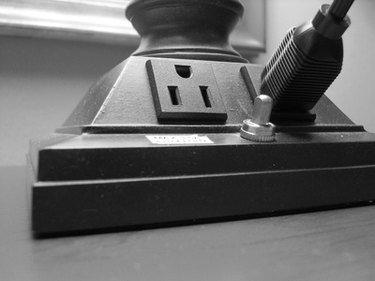Things You'll Need
Drill with 1/2' bit
Wire cutters
Wire strippers
Electrical tape
3' piece of wire
Tape measure

Wall outlets are not always where you need them...sometimes not even in the room....but you should not let wall outlets determine how you lay out a room. Running extension cords from one end of a room to another and even through walls can be very easy, and a good solution for putting appliances exactly where you want them. By following a few simple steps, you can run power from one room to another, and economically get all the electrical power you need to the places where you need it.
Step 1
Locate an open, stud-free space in your wall as close as possible to the area where you want to place your wire through the wall. Gently tap on your wall, moving horizontally across, until you hear a hollow sound. That hollow sound means that there are no studs (the vertical wooden beams that hold a house together) or other equipment in that area, making it much easier and safer to string your wire through that portion of wall.
Video of the Day
Use a stud finder for this step, or consult a plan for your home to see exactly what is between your walls. Consulting a plan is an especially good idea if you suspect there are pipes or electrical wires running through that section, although these most often run alongside studs.
Step 2
Mark the spot on one side of your wall and take exact measurements to locate the spot in relation to a side wall that continues into the next room.
Step 3
Move to the other room and, using your measurements and the side wall as a reference, mark the exact same spot on the opposite side of the wall.
Step 4
Drill a hole in the marked location, then drill the same hole on the opposite side of the wall.
Step 5
Cut off the end of your extension chord, leaving at least two inches of wire length from the power circuit or plug end of your cord.
This cut lets you move the wire through the wall without having to make a large hole to fit plugs or power strips through the wall. The cord can later be reattached once it is routed through the wall.
Step 6
Push a guide wire through one open hole and pull it out the other side. This wire will act as a guide, more easily allowing you to pull flexible wires through the wall.
Step 7
Wrap the wire around the end of your extension cord on one side of the wall. Go to the other side of the wall, and pull the wire until it is completely through the wall.
Step 8
Strip the end of the cord with wire strippers. Also strip the wire end of the piece you cut off in order to remove insulation and allow you to reconnect the cord.
Step 9
Twist the opposite wires ends together by hand. Make sure the copper wire strands are well twisted together. If the cord has internally separated wires, be sure to connect wires of the same color together.
Step 10
Wrap electrical tape around the joined bare wires. Then wrap more electrical tape to insulate the whole connection.
Step 11
Plug appliances into your power cord, and start using the new power source in the new location.
Tip
If the extension cord is visible in both or either of the rooms, consider tacking it to the wall and painting it to achieve a more finished look.
Warning
Be mindful of any electrical wires, water pipes, gas pipes or any other important items running through your walls in the area you want to drill. Consult your house plans before beginning. If you do not have house plans, drill a small pilot hole as a test.
Video of the Day